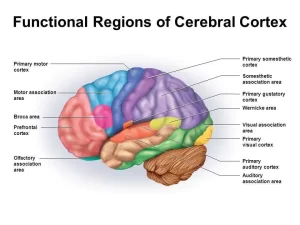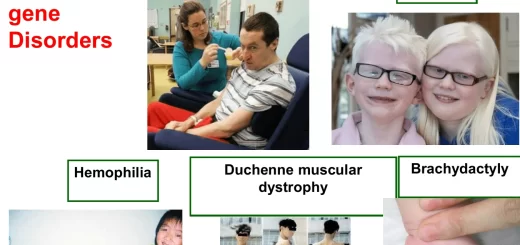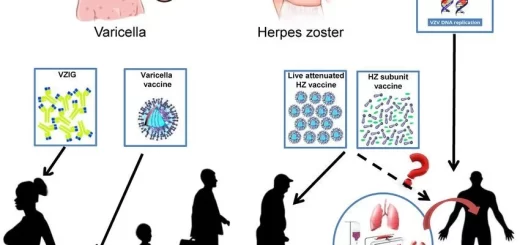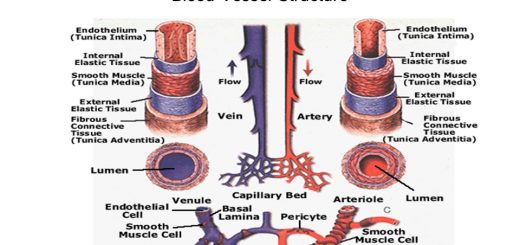Physiology of the cerebral cortex, Wernicke’s area, Broca’s area, sensory and motor areas
The cerebral cortex is the largest part of the mammalian brain, It is the wrinkly gray outer covering of the cerebrum, It is the outermost layered structure of the brain, It is considered the ultimate control and information-processing center in the brain, It is characterized as being made up of three types of areas: sensory, motor, and association areas.
Physiology of the cerebral cortex
The cerebral cortex is divided into the following main functional areas:
- Somatosensory areas.
- Motor areas.
- Prefrontal association area.
- Language areas.
I. Somatosensory areas
These areas are located in the parietal lobe and include:
- The (primary) somatosensory area 1.
- The (primary) somatosensory area II.
- The secondary somatosensory association area.
1. Somatosensory area I (S1)
Site: this area occupies the postcentral gyrus (Brodmann’s areas 1,2 and 3), It receives fibers from the posteroventral nucleus of the thalamus via sensory radiation.
Characters
It receives sensations from the opposite side of the body, The body is represented in this area in an inverted manner but the face is not inverted i.e. foot and leg are represented medially in the posterior paracentral lobule, Trunk, chest, arm and hand in the upper half of the postcentral gyrus, The face is represented in the lower half of the postcentral gyrus.
The size of the area of representation of different parts of the body is determined by the number of receptors of that part. The cortical areas for sensation from the trunk and back are small, This area shows modality separation of different sensations i.e. the cells of the somatosensory area I are organized functionally into columns with each column is specialized in the perception of a specific modality of sensation.
Functions
This area acts as a center for the perception of the following.
- Touch which includes light touch, two-point discrimination, and vibration sense.
- Kinesthetic sensations (orientation and movements of the different parts of the body).
- Pressure.
- Discrimination of fine grades of temperature
Lesion: Unilateral lesion of S1 results in impaired position sense and impaired tactile sensation contralateral to the lesion.
2. Somatosensory area II
Site: this is a small area that lies posterior to the lower end of the postcentral gyrus.
Character: the representation of the different parts of the body in this area is much less sharp than in somatosensory area I.
Function:
- Important for distinguishing special sensory features of the objects as shape and texture.
- Important for tactile learning and tactile memory.
Lesion: difficulty in learning new features of objects based on shape or texture.
3. Somatosensory association area (areas 5 and 7)
Site: it is located in the superior parietal lobe behind the sensory area I in the parietal lobe (posterior parietal cortex). It receives afferent fibers from the primary somatic sensory areas Land Il as well as from the thalamic association nuclei. It also receives input from the visual system.
Functions:
- This area combines the various sensory information received from the primary somatic sensory areas to recognize objects (stereognosis).
- It integrates tactile and proprioceptive information from the hand before performing a voluntary movement.
- Important for spatial awareness and perception of the different parts of the body.
Lesion: damage to this area leads to an inability to recognize objects by touch (astereognosis).
II. Motor areas of cerebral cortex
1. Primary motor area (area 4)
Site: this area occupies the precentral gyrus in the frontal lobe. It contains Betz cells.
Characters:
- The body is represented in an inverted manner (the head is down while the legs are upward) however, the upper part of the face, respiratory muscles, and abdominal wall muscles are bilaterally represented.
- Cortical representation of any part of the body in area 4 is directly proportional to the complexity of its function not to its size so, the areas representing the hands and muscles of speech are larger than the areas of the trunk and legs.
Functions:
- It initiates the delicate isolated voluntary movements of the distal parts of the limbs (hands and fingers) on the opposite side of the body.
- It facilitates the spinal reflexes as the stretch reflexes.
2. Premotor area 6
Site: this area lies anterior to the primary motor area; anterior to the precentral gyrus, on the lateral and medial cortical surface; it also contains a somatotopic map of the body.
Characters: the body representation is roughly the same as that of the primary motor area.
Functions:
- Initiates gross movements on the contralateral limbs and is concerned with the control of posture.
- Shares together with the basal ganglia in the initiation of automatic associated subconscious movements like, swinging of the arms during walking.
- Involved in planning voluntary movements.
3. Supplementary motor area (SMA)
Site: it is a small area that lies anterior and superior to area 6 on the medial surface of the frontal lobe.
Characters: the body representation is bilateral and horizontal. It is less excitable than Area 4.
Functions:
- It coordinates the contraction of many muscles to provide background for the performance of fine movements, The SMA appears to be involved in bilateral movements.
- Plays a role in planning of voluntary movements.
III. Prefrontal association area
This area receives, analyses, and integrates signals from both motor and sensory cortex as well as from subcortical structures therefore it is considered as one of the cortical integrative areas, It is not involved directly with sensory perception or execution of motor actions.
Site: it is located in the anterior part of the frontal lobe; in front of area 6, It includes Brodmann’s areas 8,9,10,11,12,13,44,45,46,47.
Characters:
The prefrontal cortex is directly connected with many subcortical and cortical areas. It is divided into the dorsolateral prefrontal cortex which is involved in executive functions and the ventromedial prefrontal cortex (orbitofrontal cortex) which is involved in controlling behavior.
Functions of the dorsolateral prefrontal cortex
- Shares with the motor cortex in planning complex patterns of voluntary movements.
- Provides the ability to concentrate and promotes attention.
- Mediates working memory (Working memory is a form of temporary memory that has a short duration).
- Controls the ability to follow and obey rules.
- Controls creativity and learning.
Its storage is very limited; it can hold only a few pieces of information at any one time, Its molecular mechanism relies on the persistent firing of reverberating circuits. Working memory depends on the modulatory transmitter dopamine, (patients with disturbances in the dopamine system have problems with working memory).
Functions of the ventromedial prefrontal (orbitofrontal) cortex
- Plays a role in motivation.
- Regulates impulsive behavior.
- Involved in social decision-making.
IV. Cortical areas involved in language
Language areas are located in the categorical or dominant hemisphere (the left hemisphere around the Sylvian fissure in right-handed people). However, language production requires the integration of both language and non-language areas.
A. The non-language areas important for language production
For the spoken words, the integrity of the following areas is required:
- Primary auditory area (areas 41 and 42 In the temporal lobe) where spoken words are perceived.
- Auditory association area (area 22 to understand the meaning of the perceived words).
For the written words, the integrity of the following areas is required:
- Primary visual area (area 17) is present in the occipital cortex where written words are perceived.
- Visual association area (areas 18 and 19) to understand the meaning of the written words (visually presented words).
B. Language areas
After the interpretation of auditory or visually presented words, the word meanings are fed into a large area present in the posterior part of the superior temporal gyrus, the Wernicke’s area.
Wernicke’s area
It is present in the posterior part of the auditory association area (area 22 on the left hemisphere) in the superior temporal gyrus. The main function of this area is the analysis of sounds (associating sound with concept) for comprehension of words both spoken and written.
The lesion in this area results in difficulty in understanding language both spoken and written with impaired comprehension of sentences spoken by others. Speech production is effortless, at a normal rate, fluent well articulated. However, it cannot be understood with frequent errors in the choice of words.
The inferior parietal lobule
This area is composed mainly of two distinct regions:
- The angular gyrus (area 39): this area is involved in the translation of written words into sounds, Lesion of this area leads to an inability to understand written words only but the comprehension of spoken words is retained.
- The supramarginal gyrus (area 40): this area acts as a short-term auditory memory, it is important to remember how to sound words out to determine their spelling.
Broca’s area
It is important for language production and grammar, it projects to the motor cortex (area 4) which initiates the necessary muscle movements via the pyramidal tracts, Broca’s area is divided into two areas:
- Area 44: this area is located in the posterior part of the inferior left frontal gyrus, It is part of a network used in combining sounds into words and words into sentences for language production.
- Area 45: it is located in the anterior part of the left inferior frontal gyrus.lt processes the grammatical structure of sentences and the proper use of grammatical vocabulary and verbs. It is not directly involved in meaning.
The lesion in Broca’s area: results in speech that is slow, difficult to produce with effort, and articulation is impaired. Comprehension is largely preserved for single words and grammatically simple sentences. Patients seem to comprehend (but cannot comprehend grammatically complex sentences due to defects in grammatical processing).
Histological structure of the Cerebral cortex and Types of neurons in the cerebral cortex
Blood supply of CNS (central nervous system), Carotid system, and Circle of Willis
Referred pain examples, Causes of neuropathic pain, and Pain control mechanisms
Physiology of sensory receptors, Coding of sensory information, and Somatic sensation
Skull function, anatomy, structure, views and Criteria of neonatal skull




